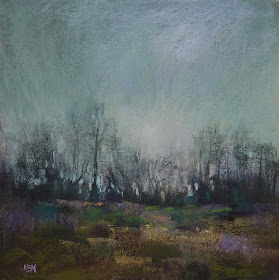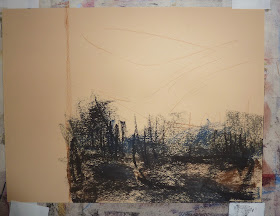 |
| 'In the Mood' 9x9 pastel ©Karen Margulis available $160 |
Like many artists new to pastels I started out using Canson Mi-Teintes paper, some NuPastels and some Rembrandts. And like many I struggled with this combination. I couldn't get the rich colors that I admired in pastel paintings. Mine were muddy. Once I discovered sanded paper and softer pastels I stopped using Canson. Over the years I have revisited Canson and now I love it. What I discovered is that I had better luck when I developed a lighter touch and when I used softer pastels. If you are like me and don't enjoy Canson, let me share what I like about it and perhaps I can convince you to give it another try!
- It is inexpensive and readily available even in local craft & hobby stores.
- It comes in many colors so no need to tone your paper
- It is versatile with a bumpy and smooth side. Use the bumpy side if you want texture. I prefer the smooth side.
- It has a wonderful soft feel which is so nice to work on.
- It is easy to blend areas if you like blending. I like to blend in my first layer to give me a 'ghost' image underpainting. It is harder to blend on sanded paper since it grabs the pastel.
- It is a great teacher...it teaches you to have a lighter touch and to make each stroke count.
Yes it is true that Canson holds less layers of pastel than sanded papers but you may be surprised at how much it can hold. I did a layer test and got 11 layers of soft pastels vs. only 7 layers of NuPastels (harder). Some artists sand their Canson to raise the nap but 11 layers is enough for me! Yes it is true that you can't do wet underpaintings on Canson but I can do a soft, blended dreamy underpainting which is wonderful.
It may not be as forgiving as sanded papers in that you can't wash off a painting but you can brush out areas and use workable fixative if you want to make corrections. I do love the choice of colors but my favorite color is Moonstone which is a warm medium gray. It works for everything. I will certainly use sanded paper when I want to do wet underpaintings but no longer will I hesitate using Canson. In fact I just ordered some more!
In case you were wondering how to pronounce Mi-Teintes and what it means. I looked it up and it means 'Mid Tones' in French and it is pronounced 'Me Taunts'
 |
| The beginnings of the painting....blocking in the darks |
 |
| Adding a layer everywhere before blending in the first layer. I did use Blair workable fixative to build up layers in the ground but none in the sky. |

Hi Karen,
ReplyDeleteI've been using Mi-Tientes Touch boards. Are they the same as plain Mi-Tientes?
I love the rigidity and the thickness of these boards. I'm finding issues with the white, however. They just do not hold as much pastel than the black. Am I imagining this? Are they totally different products?
What is your suggestion for someone who likes to work on a board as opposed to paper?
Thanks!
Hi Peggy, The boards only allow you to work on the bumpy textured side and I tend to prefer the smooth side of the paper. When I do work on the boards I tend to rub I the first layer to fill in some of the bombs. I don't think that the white and black are different but I don't know that for sure.
ReplyDeleteI love Canson Mi-Teintes and I really like the texture!
ReplyDeleteFabriano Tiziano is another similar paper, also comes in many beautiful colors and is a similar texture to the Canson, but a little bit "toothier". Strathmore has many fine drawing papers and one "ribbed" paper I have used with some interesting effect. Hahnemuhle Ingres and Pastel Velour papers are also lovely - the later especially for little vignettes of fruit or flowering branches. I just love paper in all the varieties - it's pretty much why my two favorite mediums are pastel and watercolor!
Hi I just did a portrait on mi teintes. I used sennelier pastels which worked beautifully. It left a lot of dust on the easel so I'm wondering if I need to spray fixative on the finished painting before framing. The subject is white and light tones on dark blue paper so I dont want to destroy the brightness by spraying.
ReplyDeleteWhat would you do?
Hi I just did a portrait on mi teintes. I used sennelier pastels which worked beautifully. It left a lot of dust on the easel so I'm wondering if I need to spray fixative on the finished painting before framing. The subject is white and light tones on dark blue paper so I dont want to destroy the brightness by spraying.
ReplyDeleteWhat would you do?
HI, I prefer not to use any final fixative. I find it can darken and dull the colors. Instead I just give the painting a hit on the back to dislodge any loose pastel and store it flat under glassine paper.
ReplyDelete